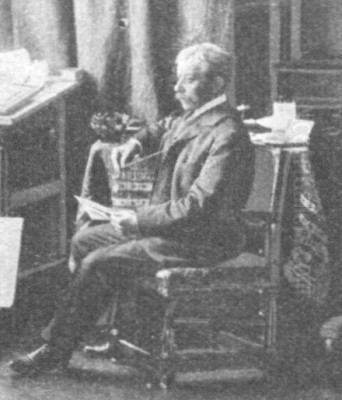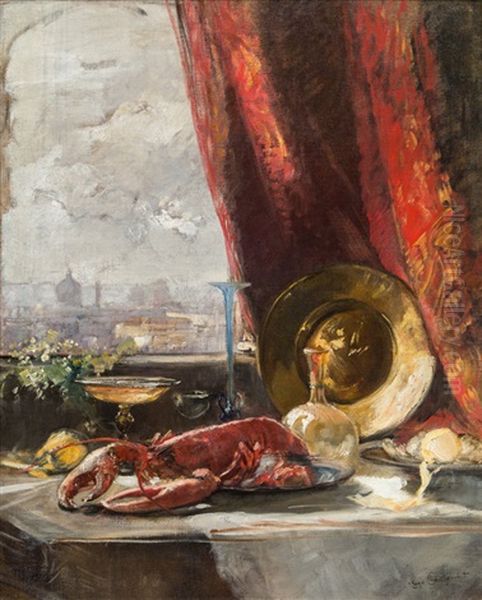
Hugo Charlemont stands as a significant figure in Austrian art history, an artist whose career spanned a period of immense cultural and artistic transformation in Vienna. Active from the latter decades of the 19th century well into the 20th, Charlemont (1850-1939) navigated the currents of tradition and modernity, establishing himself primarily as a master of meticulously rendered still lifes and evocative landscapes, though his talents extended to portraiture and genre scenes. Born into a family deeply embedded in the arts, he developed a distinctive style characterized by technical precision, a keen eye for detail, and a subtle sensitivity to light and atmosphere, earning recognition both within the Austro-Hungarian Empire and internationally.
An Artistic Heritage: Early Life and Education
Hugo Charlemont was born on March 18, 1850, in Jamnitz (Jemnice), Moravia, then part of the Austrian Empire (now in the Czech Republic). Artistry was in his blood. His father, Matthias Adolf Charlemont, was a painter specializing in miniatures, providing an early exposure to the discipline and craft of visual representation. Furthermore, Hugo was the brother of two other notable artists: Eduard Charlemont (1848–1906), who gained fame for his historical genre scenes and Orientalist paintings, and Theodor Charlemont (1859–1938), who worked as both a painter and sculptor. This familial environment undoubtedly fostered Hugo's artistic inclinations from a young age.
Seeking formal training, Charlemont moved to Vienna, the vibrant imperial capital and a major European cultural hub. He enrolled at the prestigious Academy of Fine Arts (Akademie der bildenden Künste Wien). There, he honed his skills under the tutelage of Eduard von Lichtenfels (1833-1903), a respected landscape painter known for his atmospheric depictions of Austrian scenery. This training provided Charlemont with a strong foundation in academic drawing and painting techniques, emphasizing realism and careful observation – principles that would remain central to his work throughout his long career.
Style and Development: Realism Meets Impressionistic Sensitivity

Hugo Charlemont's artistic output is primarily characterized by a refined Realism. His works demonstrate an extraordinary commitment to capturing the tangible qualities of the world around him. Whether depicting the lustrous skin of fruit, the delicate petals of a flower, the reflective surface of polished wood, or the varied textures of fabrics, his brushwork is often precise and controlled, revealing a deep understanding of form, texture, and material.
However, Charlemont was not immune to the artistic innovations of his time, particularly the influence of Impressionism that was filtering into Vienna from Paris. While he never fully embraced the broken brushwork or dissolved forms of French Impressionists like Claude Monet or Camille Pissarro, his later landscapes and some still lifes show a heightened awareness of light and color. He demonstrated a greater interest in capturing fleeting atmospheric effects, employing a brighter palette and sometimes a looser, more suggestive handling of paint, particularly in outdoor scenes. This blend of academic solidity and impressionistic sensitivity gives his work a unique quality.
His versatility is also noteworthy. While best known for still lifes and landscapes, Charlemont was also adept at portraiture, capturing the likeness and character of his sitters with clarity. He also painted genre scenes, often intimate depictions of daily life or studio interiors, and occasionally animal studies, all rendered with his characteristic attention to detail.
The Mastery of Still Life
It is arguably in the genre of still life that Hugo Charlemont achieved his most consistent and celebrated success. He elevated the painting of inanimate objects to a high art, creating compositions that are both visually sumptuous and technically brilliant. His still lifes often feature arrangements of fruit, flowers, vegetables, silverware, porcelain, glassware, and objets d'art, meticulously arranged on tables or within interior settings.
Charlemont possessed an exceptional ability to render textures – the fuzz on a peach, the coolness of metal, the transparency of glass, the intricate patterns of a carpet. He paid close attention to the play of light on surfaces, using highlights and shadows to define form and create a sense of depth and realism. Works like Still Life with Fruits and Wine Glass or compositions featuring game birds and hunting paraphernalia showcase this technical prowess. His interiors, sometimes depicting corners of studios or elegant rooms, are imbued with a quiet, contemplative atmosphere, inviting the viewer to appreciate the beauty found in everyday objects and carefully curated spaces. There's often an echo of the Dutch Golden Age masters, such as Willem Kalf or Jan Davidsz. de Heem, in the richness and precision of his still life work, yet filtered through a 19th-century Viennese sensibility.
Landscapes: Capturing Austrian Atmosphere
Hugo Charlemont's landscape paintings offer a different facet of his artistic personality. Often depicting scenes from the Austrian countryside, parks, gardens, or perhaps views encountered during his travels, these works reveal his skill in capturing the nuances of natural light and atmosphere. While grounded in realistic observation, his landscapes frequently possess a lyrical quality, influenced perhaps by the Austrian tradition of "Stimmungsimpressionismus" (Atmospheric Impressionism).
This local variation of Impressionism, championed by artists like Emil Jakob Schindler (1842-1892), focused less on the scientific analysis of light and color seen in French Impressionism and more on conveying a specific mood or feeling associated with a landscape, often through subtle tonal harmonies and evocative light effects. Charlemont’s landscapes, while perhaps more detailed than Schindler’s, share this interest in atmosphere. He depicted tranquil forest interiors, sun-dappled garden paths, and expansive rural views, often employing a richer, more varied palette than in his tightly controlled still lifes. Fellow Austrian landscape painters like Tina Blau (1845-1916) and Olga Wisinger-Florian (1844-1919), also influenced by Impressionism, were contemporaries exploring similar themes.
Portraits, Genre Scenes, and Public Commissions
Beyond his primary focus, Charlemont demonstrated competence in other areas. His portraits are characterized by their straightforwardness and solid rendering, capturing a good likeness without excessive flattery. His genre scenes often provide glimpses into bourgeois life or artistic environments, rendered with the same meticulous detail found in his still lifes. These works offer valuable insights into the tastes and settings of Viennese society during his time.
A significant undertaking that showcased his ability to work on a larger scale was his contribution to the decoration of the prestigious Burgtheater in Vienna. Alongside other prominent artists of the era, including his brother Eduard and the celebrated Gustav Klimt (1862-1918), Hugo Charlemont was commissioned to paint decorative panels or murals for this important cultural institution, a testament to his standing within the Viennese art establishment. He reportedly created three large paintings for the theatre, contributing to the opulent Gesamtkunstwerk (total work of art) envisioned for the Ringstrasse buildings.
Exhibitions and Recognition
Throughout his career, Hugo Charlemont actively participated in the Viennese art scene, regularly exhibiting his works at the Vienna Künstlerhaus, the traditional bastion of established artists in the city. His technical skill and appealing subject matter ensured a steady market for his paintings among collectors and the bourgeoisie.
His reputation extended beyond Austria. As noted in some sources, he participated in the Paris Salons, the highly competitive annual exhibitions in the French capital. Receiving an honorable mention at the Salon was a significant achievement, indicating recognition from the international art world centered in Paris at the time. This exposure would have brought his work to the attention of a wider audience and placed him in dialogue, however indirectly, with French contemporaries like Jean-Léon Gérôme or William-Adolphe Bouguereau, who dominated the Salons with their academic styles, as well as the Impressionists exhibiting independently.
The Charlemont Artistic Dynasty
Understanding Hugo Charlemont requires acknowledging the artistic context of his family. His father, Matthias Adolf, provided the foundational artistic environment. His brother Eduard achieved considerable international fame, particularly for his detailed historical genre scenes and vibrant Orientalist paintings, such as the often-cited The Moorish Chief. Eduard's style, while also detailed, often leaned towards narrative and exoticism, differing from Hugo's quieter focus on still life and landscape. Theodor, the younger brother, pursued both painting and sculpture, contributing further to the family's artistic prominence. While Hugo shared the family's commitment to craftsmanship, his artistic path remained distinct, characterized by his focus on realism, light, and the intimate observation of nature and objects. Distinguishing Hugo's oeuvre from Eduard's, particularly regarding genre scenes, is crucial for accurate art historical assessment.
Vienna at the Turn of the Century: A Shifting Landscape
Hugo Charlemont worked during a period of extraordinary artistic ferment in Vienna. His formative years coincided with the dominance of Hans Makart (1840-1884), whose opulent, theatrical style defined the Ringstrasse era. Following Makart's death, Viennese art began to diversify. Landscape painting gained prominence through the atmospheric works of Schindler and his circle.
The most significant upheaval came in 1897 with the founding of the Vienna Secession, led by Gustav Klimt, Koloman Moser, Josef Hoffmann, and Joseph Maria Olbrich. The Secessionists broke away from the conservative Künstlerhaus, advocating for artistic renewal, international exchange, and the integration of art and design (Jugendstil). While Charlemont remained associated with the more traditional Künstlerhaus, the Secession's radical modernism, embracing Symbolism and decorative abstraction, formed the backdrop against which his more conservative realism continued to develop. Later, the emergence of Austrian Expressionism, spearheaded by Egon Schiele (1890-1918) and Oskar Kokoschka (1886-1980), pushed Viennese art in yet another radical direction. Charlemont, therefore, represents a strand of continuity, upholding values of realism and technical skill amidst waves of avant-garde experimentation. His contemporaries included not only the Secessionists but also other skilled academic and realist painters like Rudolf von Alt (1812-1905), known for his cityscapes, or Carl Probst (1854-1924).
Legacy and Enduring Appeal
Hugo Charlemont passed away in Vienna in 1939 at the venerable age of 89, having witnessed profound changes in art and society. He leaves behind a legacy as a highly skilled and dedicated painter, a master of realism with a particular gift for the still life genre. While perhaps overshadowed in narratives of modernism by the groundbreaking innovations of Klimt or Schiele, Charlemont represents an important aspect of Viennese art history – the persistence of high-quality realist and impressionist-influenced painting that continued to find appreciation among patrons and the public.
His works are valued for their technical excellence, their meticulous rendering of detail, their sensitivity to light and texture, and their often tranquil and contemplative beauty. They offer a window into the aesthetic sensibilities of late 19th and early 20th century Vienna. Today, his paintings can be found in Austrian museums, including the Belvedere in Vienna, as well as in numerous private collections worldwide, where they continue to be admired for their enduring craftsmanship and quiet charm. He remains a testament to the diverse artistic currents that flowed through Vienna during its golden age.
Conclusion
Hugo Charlemont carved a distinct and respected niche for himself within the rich tapestry of Austrian art. As a member of a notable artistic family, he built upon his heritage and academic training to become a master observer of the tangible world. His still lifes are tours de force of technical skill and sensitivity to material qualities, while his landscapes capture the specific atmosphere of the Austrian environment with a blend of realism and impressionistic light. Though working during a time of radical artistic change dominated by the Vienna Secession and later Expressionism, Charlemont maintained his commitment to representational accuracy and fine craftsmanship, creating a body of work that continues to delight viewers with its precision, beauty, and quiet dignity. He stands as a significant representative of Viennese realism and its subtle adaptation of modern influences at the turn of the century.